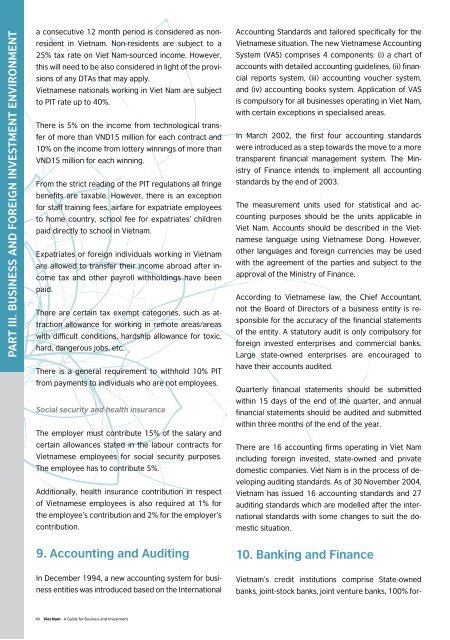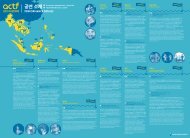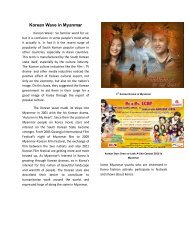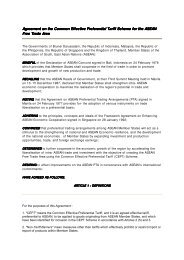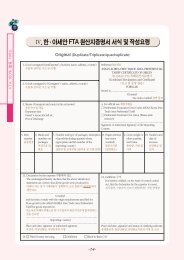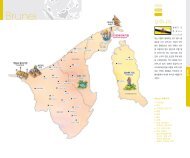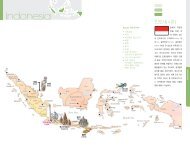Viet Nam - A Guide for Business and Investment - asean-korea centre
Viet Nam - A Guide for Business and Investment - asean-korea centre
Viet Nam - A Guide for Business and Investment - asean-korea centre
Create successful ePaper yourself
Turn your PDF publications into a flip-book with our unique Google optimized e-Paper software.
PART III. BUSINESS AND FOREIGN INVESTMENT ENVIRONMENTa consecutive 12 month period is considered as nonresidentin <strong>Viet</strong>nam. Non-residents are subject to a25% tax rate on <strong>Viet</strong> <strong>Nam</strong>-sourced income. However,this will need to be also considered in light of the provisionsof any DTAs that may apply.<strong>Viet</strong>namese nationals working in <strong>Viet</strong> <strong>Nam</strong> are subjectto PIT rate up to 40%.There is 5% on the income from technological transferof more than VND15 million <strong>for</strong> each contract <strong>and</strong>10% on the income from lottery winnings of more thanVND15 million <strong>for</strong> each winning.From the strict reading of the PIT regulations all fringebenefits are taxable. However, there is an exception<strong>for</strong> staff training fees, airfare <strong>for</strong> expatriate employeesto home country, school fee <strong>for</strong> expatriates’ childrenpaid directly to school in <strong>Viet</strong>nam.Expatriates or <strong>for</strong>eign individuals working in <strong>Viet</strong>namare allowed to transfer their income abroad after incometax <strong>and</strong> other payroll withholdings have beenpaid.There are certain tax exempt categories, such as attractionallowance <strong>for</strong> working in remote areas/areaswith difficult conditions, hardship allowance <strong>for</strong> toxic,hard, dangerous jobs, etc.There is a general requirement to withhold 10% PITfrom payments to individuals who are not employees.Social security <strong>and</strong> health insuranceThe employer must contribute 15% of the salary <strong>and</strong>certain allowances stated in the labour contracts <strong>for</strong><strong>Viet</strong>namese employees <strong>for</strong> social security purposes.The employee has to contribute 5%.Additionally, health insurance contribution in respectof <strong>Viet</strong>namese employees is also required at 1% <strong>for</strong>the employee’s contribution <strong>and</strong> 2% <strong>for</strong> the employer’scontribution.Accounting St<strong>and</strong>ards <strong>and</strong> tailored specifically <strong>for</strong> the<strong>Viet</strong>namese situation. The new <strong>Viet</strong>namese AccountingSystem (VAS) comprises 4 components: (i) a chart ofaccounts with detailed accounting guidelines, (ii) financialreports system, (iii) accounting voucher system,<strong>and</strong> (iv) accounting books system. Application of VASis compulsory <strong>for</strong> all businesses operating in <strong>Viet</strong> <strong>Nam</strong>,with certain exceptions in specialised areas.In March 2002, the first four accounting st<strong>and</strong>ardswere introduced as a step towards the move to a moretransparent financial management system. The Ministryof Finance intends to implement all accountingst<strong>and</strong>ards by the end of 2003.The measurement units used <strong>for</strong> statistical <strong>and</strong> accountingpurposes should be the units applicable in<strong>Viet</strong> <strong>Nam</strong>. Accounts should be described in the <strong>Viet</strong>nameselanguage using <strong>Viet</strong>namese Dong. However,other languages <strong>and</strong> <strong>for</strong>eign currencies may be usedwith the agreement of the parties <strong>and</strong> subject to theapproval of the Ministry of Finance.According to <strong>Viet</strong>namese law, the Chief Accountant,not the Board of Directors of a business entity is responsible<strong>for</strong> the accuracy of the financial statementsof the entity. A statutory audit is only compulsory <strong>for</strong><strong>for</strong>eign invested enterprises <strong>and</strong> commercial banks.Large state-owned enterprises are encouraged tohave their accounts audited.Quarterly financial statements should be submittedwithin 15 days of the end of the quarter, <strong>and</strong> annualfinancial statements should be audited <strong>and</strong> submittedwithin three months of the end of the year.There are 16 accounting firms operating in <strong>Viet</strong> <strong>Nam</strong>including <strong>for</strong>eign invested, state-owned <strong>and</strong> privatedomestic companies. <strong>Viet</strong> <strong>Nam</strong> is in the process of developingauditing st<strong>and</strong>ards. As of 30 November 2004,<strong>Viet</strong>nam has issued 16 accounting st<strong>and</strong>ards <strong>and</strong> 27auditing st<strong>and</strong>ards which are modelled after the internationalst<strong>and</strong>ards with some changes to suit the domesticsituation.9. Accounting <strong>and</strong> Auditing10. Banking <strong>and</strong> FinanceIn December 1994, a new accounting system <strong>for</strong> businessentities was introduced based on the International<strong>Viet</strong>nam’s credit institutions comprise State-ownedbanks, joint-stock banks, joint venture banks, 100% <strong>for</strong>-40 <strong>Viet</strong> <strong>Nam</strong> - A <strong>Guide</strong> <strong>for</strong> <strong>Business</strong> <strong>and</strong> <strong>Investment</strong>


